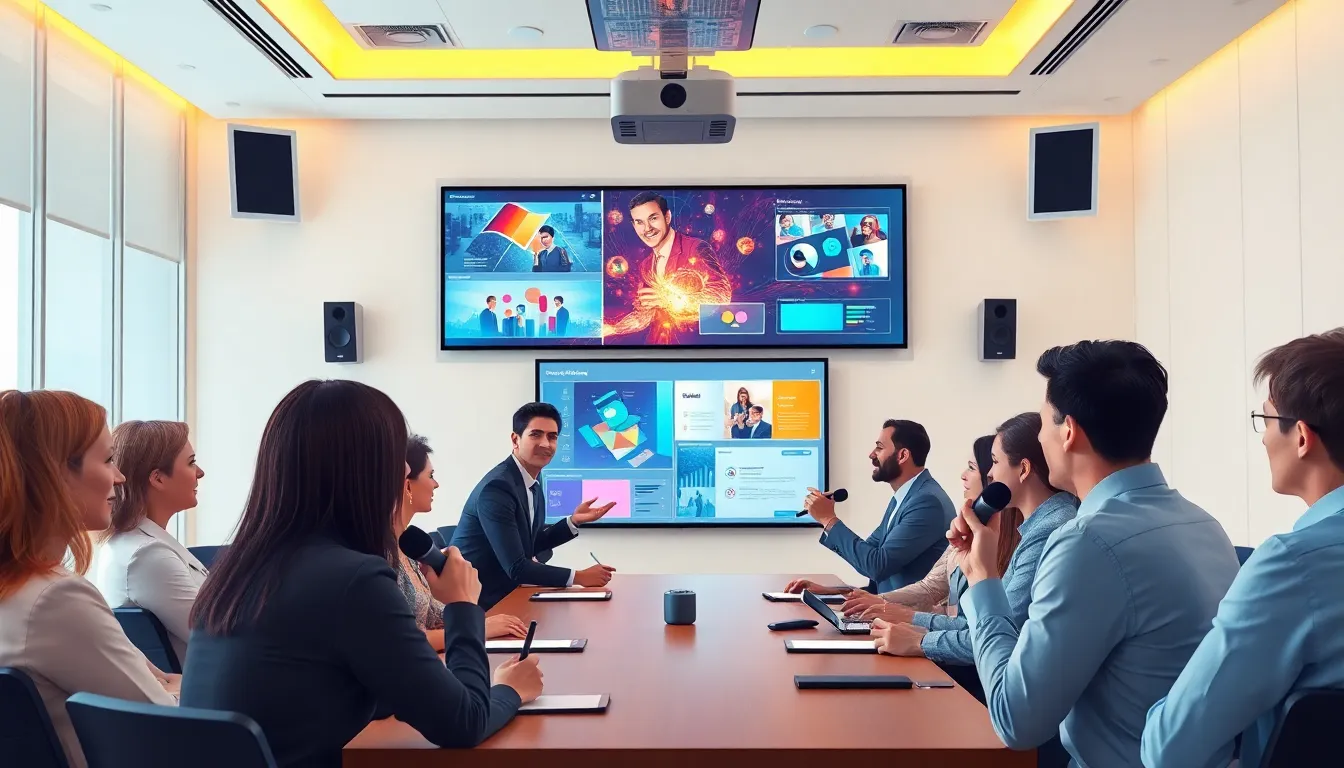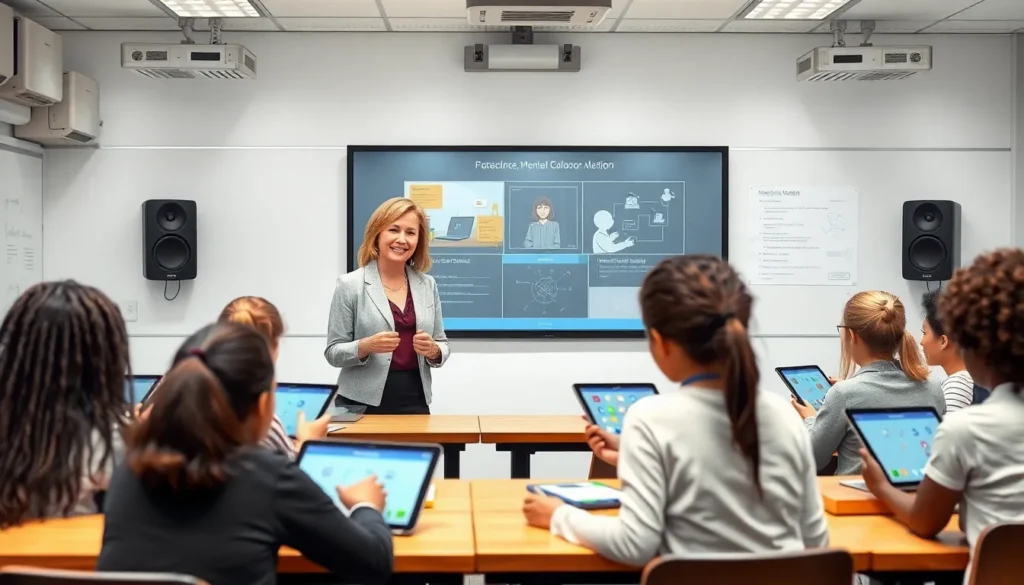Table of Contents
ToggleIn a world where a picture is worth a thousand words, audio visual technology takes that concept and cranks it up to eleven. Imagine transforming mundane presentations into captivating experiences that keep audiences on the edge of their seats. Whether it’s dazzling graphics or immersive soundscapes, this tech isn’t just for movie buffs or tech geeks; it’s a game-changer for businesses, educators, and entertainers alike.
What Is Audio Visual Technology?
Audio visual technology combines sound and visual elements to create engaging experiences. This integration includes equipment such as projectors, microphones, speakers, and video conferencing platforms. Each component plays a crucial role in delivering information and exceptional presentations.
Organizations utilize audio visual technology to enhance communication. Videos or animations, for instance, capture attention and convey messages effectively. In educational settings, interactive displays and smartboards facilitate collaborative learning and improve student engagement.
Entertainment industries also heavily rely on audio visual elements. Movie theaters, for example, implement advanced projection systems and surround sound to immerse audiences. Live performances, including concerts and theater productions, frequently use sophisticated sound systems and lighting effects to elevate the viewing experience.
Businesses leverage audio visual technology to optimize meetings and training sessions. Video conferencing tools enable real-time collaboration, allowing teams to connect regardless of their location. Presenters use slideshows and multimedia presentations to make information more digestible and retain audience interest.
Audio visual technology serves multiple sectors, enhancing communication and engagement through its dynamic capabilities. As it continues to evolve, newer innovations like virtual reality and augmented reality will further transform how audiences interact with content.
Key Components of Audio Visual Technology

Audio visual technology consists of various essential components that contribute to its effectiveness in creating engaging experiences. Understanding these components provides insights into how they enhance communication and interaction.
Audio Equipment
Audio equipment plays a crucial role in delivering clear sound. This category includes microphones, speakers, and sound mixers. Microphones capture audio input, while speakers project sound to the audience. Sound mixers allow operators to control volume and audio quality, ensuring optimal listening experiences. Wireless microphones facilitate mobility during presentations or performances. Advanced sound systems often feature surround sound setups that create an immersive auditory experience, making content more impactful.
Visual Equipment
Visual equipment comprises devices used for displaying images and videos. Projectors and screens serve as the primary tools for showcasing visual content. High-definition projectors deliver crisp images, enhancing viewer engagement. Large LED displays provide vibrant visuals in various settings, from conferences to live events. Video conferencing systems integrate cameras and displays, enabling remote collaboration and interaction. Digital signage utilizes screens to convey messages dynamically, capturing audience attention effectively. Each visual component contributes to the overall effectiveness of audio visual technology in engaging and communicating with diverse audiences.
Applications of Audio Visual Technology
Audio visual technology plays a pivotal role across various sectors, enhancing engagement and communication. Its applications in education, business, and entertainment showcase its versatility.
In Education
Audio visual technology transforms classrooms into interactive learning environments. Educators use tools like smartboards and projectors to present information dynamically. Students engage better with multimedia content, fostering collaborative learning experiences. Video conferencing platforms enable remote learning, bridging gaps between teachers and students. Courses often integrate animations and videos, which simplify complex topics, making them more accessible. Various institutions adopt these technologies to improve retention rates, illustrating their significant impact on learning.
In Business
Businesses utilize audio visual technology to optimize meetings and training sessions. Video conferencing tools facilitate real-time collaboration, allowing teams to connect seamlessly across locations. Multimedia presentations keep audiences engaged and enhance message retention. Digital signage in offices promotes important announcements, streamlining internal communication. Moreover, companies regularly incorporate audio visual elements in marketing strategies, creating impactful advertisements that resonate with customers. Effective use of these technologies ultimately leads to improved productivity and collaboration within organizations.
In Entertainment
The entertainment industry heavily relies on audio visual technology to create immersive experiences. Advanced projection systems and surround sound enhance the viewing experience in theaters, captivating audiences. Live performances incorporate sophisticated sound systems and lighting effects, enriching the atmosphere. Streaming platforms leverage audio visual tools to deliver high-quality content to viewers, meeting the demand for engaging entertainment. Festivals and events also embrace these technologies, utilizing large screens and vibrant audio to engage large crowds. Overall, audio visual technology significantly elevates the quality of entertainment consumed by audiences.
Benefits of Using Audio Visual Technology
Audio visual technology offers numerous advantages across various sectors. Enhanced communication stands out as a primary benefit. Organizations utilize it to convey messages effectively, using visuals and sound to capture audience attention.
Improved engagement drives user satisfaction. When people experience dynamic presentations, they retain information better. Active participation increases significantly, particularly in educational settings where interactive tools enhance learning.
Collaboration receives a significant boost. Businesses leverage video conferencing tools to connect employees across geographical locations. Real-time interactions foster teamwork and drive project success.
Cost efficiency represents another major advantage. Audio visual solutions often reduce the need for travel. Organizations can conduct meetings and training remotely, saving money on accommodations and transportation.
Flexibility in applications adds versatility. Events like webinars and virtual conferences maximize reach and allow for diverse audience interaction. Various industries, from corporate to creative, benefit from tailored audio visual setups.
Quality and clarity enhance overall experiences. High-definition visuals and crisp audio create immersive environments. Audiences enjoy a richer interaction whether in classrooms, boardrooms, or theaters.
Marketing strategies gain strength. Engaging multimedia content effectively introduces products or services, capturing customer interest. Compelling advertisements often rely on audio visual elements to drive sales conversions.
Overall, audio visual technology serves as a powerful tool that transforms communication and engagement. Its continuous evolution promises even greater potential, impacting diverse fields now and in the future.
Future Trends in Audio Visual Technology
Emerging audio visual technologies continue to shape how organizations communicate and engage. Artificial Intelligence (AI) integration streamlines content creation, allowing for real-time editing and enhancements in multimedia presentations.
Augmented Reality (AR) and Virtual Reality (VR) applications are transforming experiential learning and entertainment, enabling immersive environments that capture audience attention. These technologies facilitate unique interactions, making training sessions and events more dynamic.
Cloud-based solutions are becoming essential for remote access to audio visual content. Video conferencing platforms are evolving to offer higher quality streaming and enhanced collaboration features. Organizations can now conduct seamless hybrid meetings, merging in-person and virtual participants.
Accessibility technology is seeing significant advancements, ensuring that audio visual content is inclusive for all individuals. Features like closed captioning and audio descriptions enhance user experience and expand audience reach.
Data analytics plays a crucial role in monitoring audience engagement. This information helps organizations refine their strategies and tailor presentations to meet viewer preferences, leading to improved outcomes.
Sustainability remains a priority as energy-efficient equipment gain popularity. Manufacturers are focusing on eco-friendly materials and technologies that reduce environmental impact while maintaining quality.
Overall, the future of audio visual technology promises greater interactivity, inclusivity, and sustainability. Continued innovation ensures that the experiences provided by this technology remain engaging for diverse audiences in various sectors.
Audio visual technology is reshaping how individuals and organizations communicate and engage. Its ability to blend sound and visuals creates memorable experiences that captivate audiences across various sectors. From enhancing educational environments to optimizing business meetings and enriching entertainment, the applications are vast and impactful.
As technology continues to evolve, the integration of AI, AR, and VR further enhances these experiences, making them more interactive and immersive. The focus on accessibility and sustainability ensures that audio visual technology remains inclusive and environmentally friendly. Embracing these advancements will undoubtedly lead to even more innovative ways to connect and inspire audiences in the future.







